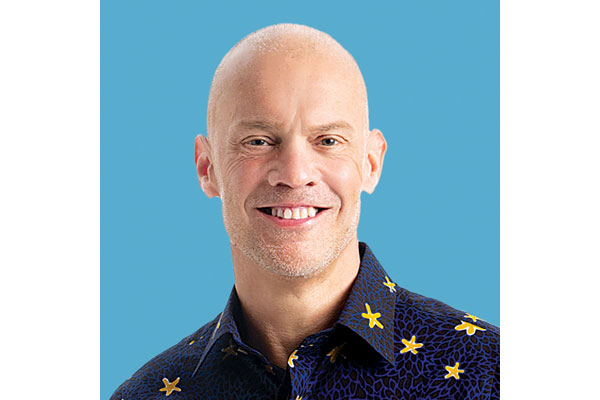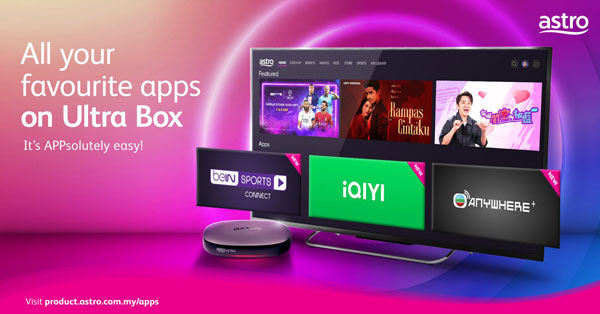Ahead of his keynote address at APOS in Singapore next week, Euan Smith, CEO of TV and group COO at Malaysia’s Astro, talks to TV Asia about how the platform is positioning itself as a hub for content, local and imported, apps and services over multiple pricing tiers.
The next battleground in the global streaming wars is Asia, and for those OTT players eyeing fast-growing markets like Southeast Asia and India, the role to be played by incumbent pay-TV operators should not be discounted, Smith tells TV Asia.
WS: Before we get into all things Astro, I’m curious about your thoughts on the role Asia is playing in the global streaming wars. The region has been key to the subscriber gains at Netflix and Disney+.
SMITH: It feels like the region is tracking about three years behind what’s been happening in the U.S. and Europe. There’s a surge in OTT players, with lots of people coming into the market. We are quickly getting to the point of saturation, with everybody coming and playing in Southeast Asia. People increasingly see it as fertile ground, with significantly more of a mobile-first viewership population than Australia or the U.S.; Southeast Asia is an area of growth they can point to. As an example, Disney+ went past Netflix in terms of total global numbers, and they’re one of the players now heavily focused on the region. As markets reach maturity, you’re starting to see the first OTT disruptors get disrupted. It’s going to happen in Southeast Asia as well. If you look underneath the stats, I read that for every dollar that Netflix makes from its customer base, Disney makes about $0.14. Assuming that’s true, the price of the product is under a lot of threat. There’s only so much great content that can get made, and over time, the shift in the powerbase will be toward the guys who have the best content. That’s why many of the major OTT players are keen on keeping their content locked in and being cautious on distribution deals. They’re not interested in sharing content amongst themselves, which brings me to pay-TV land. As services proliferate and inflation increases, the OTT players all realize that the growth of their machines will come, in significant part, from distributors like Astro. We’ve got 71 percent of Malaysian eyeballs. If [an OTT platform] wants to keep telling a growth story, it has to either start raising prices—and the market is not letting it do that—or get growth in volume. For a pay-TV operator, this is good news. Our game hasn’t changed. Astro is 26 years young, and we’ve always been about three things: Make great local content that resonates. Build a home of sports offers that is compelling. And then aggregate the best of the rest. Fifteen years ago, that aggregation used to be channels. Today, aggregating the best content is increasingly the apps. That’s where the play is for a pay-TV operator. We used to put lots of channels together. Now we put lots of apps together. The OTT players will find it hard to aggregate all their services among themselves. Someone has to be agnostic. Someone has to create a compelling, simple UI and a search and discovery function that cuts through that all. When you add Astro’s own local content and sports offer to the mix, we feel pretty bullish about Astro’s role in the environment.
WS: Disney has pulled the plug on most of its linear channels. Do you expect to see more of that happening?
SMITH: I think over time you will see more linear channels dropping away. But there is an inherent inertia in the business model, as transitions take time. Some people are looking at Disney’s move and thinking that perhaps that was a bridge too far. But I think you’ll see a reduction of linear channels over time and a move to assets. For Astro, it’s not really different. As an aggregator, if we’re aggregating content on a home screen, effectively we’re making channels; they just look like rails on the screen rather than in a traditional EPG. The other interesting thing is, two, three years ago, most of the OTT players were saying, We’re a subscription play; ads are not our thing. And suddenly, with the squeeze on growth, everyone now wants to have two revenue streams: one from advertising, one from subscription. The mechanics are simple—if one revenue stream drops, the other can compensate to an extent. For a pay-TV operator, we’ve been running that same model for 26 years. It’s almost like the industry is heading back to square one.
WS: There is something to be said for the lean-back, linear channel viewing experience.
SMITH: As apps proliferate, maybe the top four or five that populate the left of the rails on the screen (or in the stores) are uppermost in people’s minds. People are prepared to go in and look for content on Netflix, Disney+ Hotstar and iQIYI. But if you’re an app at number seven, eight, nine, ten position, unless you have a stand-out tentpole that people know like, perhaps, Paramount’s Star Trek, how will your great content get surfaced? We’re saying, We’ll aggregate the whole thing, make search and discovery simple and easy, and ensure your content is visible. Increasingly I believe that that’s how the model will go for most of the players, apart from perhaps the top three or four.
WS: Tell us about the consumer proposition and how you differentiate the offerings across Astro, sooka and NJOI.
SMITH: Astro used to be a traditional satellite single play. You had one box, there were a bunch of packages, and you bought into them. The rise of the internet has changed the game completely. The first thing we have had to do is become transmission-agnostic and put the content that people are buying wherever they want it to happen. And then, we need to make it easier for them to find and surface what they want in this increasingly complex world. That’s why our Ultra and Ulti boxes exist. First, you can get the premium 4K experience on the Ultra box, but if you’re not in that market segment, our Ulti HD box sells at a lower price with just the same UI look and feel. Second thing, the boxes can’t just be satellite these days, so they’re not. Both boxes are hybrid and work just as well over the internet. We’re no longer a “dish” company; we’re a streaming company. Third is that you need to give people value for their subscription when they are not in the home, which is why we’re spending a lot of money on improving the functionality and features of Astro GO so that a customer can carry all 65,000 titles in their pocket.
Similarly, Astro used to be a one-size-fits-all product. That’s not how the market works these days. So we’ve divided ourselves into three tents. Customers may want the full-fat experience, which is family first, big screen, all the sparkling content you possibly could want, available in various packages with bundled apps. That is Astro. But there are two groups of customers who don’t want that. One wants a very laid-back experience; it wants the big screen, a pick-and-mix experience. We have NJOI for those people. They don’t want a long contractual relationship with Astro; they don’t need some of the premium that comes with an Astro subscription. So NJOI is a free sat service, and we make it super simple so that when you do want extra content, you can buy up. It’s a prepaid model for customers who wish to dip in and out, which we are converting to HD.
Then there are those who don’t choose Astro because they tend to be more mobile. They wouldn’t want the NJOI model, so for them we have sooka. It’s single-use first and skewed to a younger demographic. It allows us to target a different audience in a slightly different way. Whereas Astro is sleek and premium, sooka is more fun and quirky; it has a more youthful vibe. We’re building content that is exclusive to sooka. It’s an app. It’s a cool way to monetize our content in a different space, which is very different from the main pay-TV engine, and we are seeing some really good engagement in terms of stats. We built sooka such that even if you don’t subscribe, there’s an ad layer. So even if you’re just a casual user, we can serve you some ads and get value from the platform even if you’re not ready to have a full-blown relationship with Astro.
Going back three decades, we reinvented Malaysian TV in the pay-TV space. The journey now is to reinvent ourselves around these three products.
WS: Tell us about the introduction of Astro Fibre.
SMITH: The CEO of a pay-TV company I used to work for said, “We’re now a broadband service that happens to make TV.” That says quite a lot about the direction that many in the market are traveling. We’re going to make and aggregate all of this sparkling content, and we’re going to deliver it in a great value proposition. If you buy all the [OTT subscriptions] separately, the price you pay is at a premium to buying them all through Astro, and you don’t get Astro’s great content alongside. In our model, you have just a single bill and an all-in-one experience. The obvious step from that is, well, our world is increasingly about streaming, about connectivity, about the connected home. For a time now many of our customers have been saying, “I would like to be able to bundle my broadband into what you are doing.” That’s why we launched Astro Fibre. We knew it would be such a key pillar of our business going forward that we have built our own network. Now, we can take the broadband and TV bundle and create really compelling offers in the marketplace. Most of the broadband providers will be selling on reliability, speed and price. We can also engage consumers around the content, which is significantly sexier than talking about reliability, speed and price! We have a bit of a USP and a large customer base that we can take that proposition, too. We launched Fibre as a bundled offer back in March. In May, we launched a stand-alone product, so now we can sell you broadband even if you don’t have an Astro subscription. Over time, we can build you a broadband solution with your NJOI product or your sooka product. We see Fibre as being the fourth pillar of our portfolio. It’s Astro pay TV, sooka or NJOI, and Fibre across the three.
WS: The streamers are getting more involved in sports worldwide. Is that resulting in increased sports rights prices?
SMITH: There’s always going to be inflationary pressure on sports rights. Look at the recent IPL—the IP rights sold for an extraordinary value in addition to the broadcast. It remains to be seen whether those ecosystems can live together at the pricing points they will need to bring customers in. That’s a TBD, and I fear that one or other of those models will, unfortunately, fall over, or at least be unable to deliver the kind of margins they were expected to. People like Prime Video are coming into the marketplace in the U.K. to buy EPL and now Champions League. People are clearly signaling that the next value proposition, now that entertainment is saturated, is creating USPs in sports. The great news for Astro is that we have really strong relationships with our partners. Most of the sports rights holders we’re talking to understand that if you’re not on Astro, 71 percent of the eyeballs aren’t looking at you. The business model when you’re not already in the market is difficult to create, which is good for us as it is all about distribution. But we’re trying to be better too; to retain our reputation as the home of sports. We’re known for sports in Malaysia, so we’re buying the content that makes the most difference, alongside building new sports markets. As an example, this year sooka is sponsoring the Netball Superleague. That builds the genre. We’re interested in building sports where there’s a fan base, not just the big-ticket things.
WS: Your previous companies, Sky and Foxtel, have set the bar in terms of driving innovation in the pay-TV space. How are you and your teams working to ensure that you’re constantly improving the overall experience for your consumer?
SMITH: We have a pretty strong roadmap. We moved to the plug-and-play set-top box and have strong lower-cost products in the marketplace to serve the lower ARPU segment. We’re constantly working on how we better the hardware, such as a new remote control that is simpler and more intuitive. But our main thing is obviously the content. The role of the product in terms of innovation is, How can I get that content to be super sparkling, to showcase its premium nature? For us, it’s all about search and discovery and personalization. We’ve recently launched multi-user profiles. We have this big app aggregation campaign going on. We’re delighted to have Netflix and Disney+ Hotstar on the platform already, and by the time of the World Cup 2022, we will have four or five more apps launching into the space. Once you put all these apps into one place and have the concept of this entertainment engine, the next obvious place is music. And after that we have ideas about other apps we’ll be bringing on, for example, lifestyle and fitness. The plan is to put our service app onto the box as well. The entire roadmap is about aggregation, personalization and simplicity across the piece. We’re also updating the UI and the search and recommendation engine to make it easier for people to find things. And in the background, we are enhancing hugely the data we’re capturing so that we can make each experience better. Who is watching, what, for how long, and where are they dropping in and out? As well as being used for personalization, that data informs the addressable advertising engine we have built. Addressable advertising is now launched across almost all of our products. It allows us to determine with really good accuracy who’s watching so that we can replace an advertisement with a different advertisement to show you a different thing than the house next door. Clearly, that is of huge value to both consumers (they get relevant ads) and the clients we work with (their ads get to the right audience).
WS: Tell us about your investments in original content.
SMITH: We’ve been super aggressive at building the content pipeline since we got back into production at the end of last year. We’re making sure we’re creating content for each demographic—Malay, Chinese and Indian—that is premium. Premium in Chinese tends to skew toward business, small- and medium-sized enterprises and entrepreneurs. In Malay, it skews to big signature entertainment shows and drama. We always have a strong second half for signature shows and live events. We’re pushing harder on the concept of Astro and sooka originals. We’re increasingly about generating strong “appointment to view” content. If you’re say, Netflix, they do a lot of things, but actually they ‘do’ Stranger Things. If you’re HBO, they do lots of things, but they ‘do’ House of the Dragon. That model resonates. So our next big thing will be One Cent Thief, including some big, bold stunts. Our Astro Originals brand means great, high-quality, edgy drama. We’re trying to create more of these “wow” tentpoles in local content. Astro does so much great local content; we need to shout more about it than we have in the past. It’s what makes us different from the other players in the market—70 to 75 percent of all our viewing is on our local content.
WS: Squid Game, Money Heist and others have shown that foreign-language shows can travel successfully. Is there an opportunity to bring these originals to other markets?
SMITH: We’re in our infancy on that. Some of the kids’ IPs travel superbly. Once we’ve built more of them, the challenge for these Astro originals is to try distributing them wider than we have. Many storylines you’ll see coming through are designed with that intent, whether subtitled or dubbed. I want Astro to become known as a studio that is sending a lot of content globally.
 TVASIA
TVASIA






